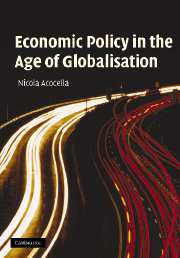Book contents
- Frontmatter
- Contents
- List of boxes
- List of tables
- List of symbols, abbreviations and acronyms
- Preface
- 1 Introduction
- Part I The market, efficiency and equity
- Part II Normative and positive theory of economic policy
- Part III Microeconomic policies
- 6 Property rights, corporate governance and public enterprises
- 7 Competition policies; policies for externalities and public goods
- 8 Industrial and regional policies; redistributive policies
- 9 Social choice and cost-benefit analysis
- Part IV Macroeconomic policies
- Part V Public institutions in an international setting
- Part VI Globalisation and the quest for a new institutional setting
- Bibliography
- Author index
- Subject index
9 - Social choice and cost-benefit analysis
Published online by Cambridge University Press: 14 May 2010
- Frontmatter
- Contents
- List of boxes
- List of tables
- List of symbols, abbreviations and acronyms
- Preface
- 1 Introduction
- Part I The market, efficiency and equity
- Part II Normative and positive theory of economic policy
- Part III Microeconomic policies
- 6 Property rights, corporate governance and public enterprises
- 7 Competition policies; policies for externalities and public goods
- 8 Industrial and regional policies; redistributive policies
- 9 Social choice and cost-benefit analysis
- Part IV Macroeconomic policies
- Part V Public institutions in an international setting
- Part VI Globalisation and the quest for a new institutional setting
- Bibliography
- Author index
- Subject index
Summary
Choice criteria in private and public projects
Welfare economics has other important practical applications in current public choices, in addition to those we discussed in previous chapters. In particular, the government can use it to assess whether to undertake a project or programme or not and to choose among mutually exclusive projects or programmes. Evaluating a project for constructing public works, establishing staff training projects, subsidising private investment and regulating pollution are some of the areas in which welfare economics can make a major contribution. With reference to the evaluation of public sector projects, we can define a public project as a change in the net supplies of commodities from the public sector. Mutually exclusive projects are those that serve (approximately) the same purpose, through alternative solutions (such as building a dam with different techniques). We will consider only small projects, which involve small changes in output and demand. When a project is large, measuring the change in welfare caused by the project requires us to take account of a large number of variables and introduces analytical complexities (see Starrett, 1988; Hammond, 1990). In assessing the effects of any project and selecting one of various alternative solutions, a government agency will measure the costs and benefits of each and will reject those that are the least attractive, much the same as a private investor would do.
As a basis for an investment decision, a private entrepreneur prepares a list of costs and revenues for each alternative investment project.
- Type
- Chapter
- Information
- Economic Policy in the Age of Globalisation , pp. 209 - 228Publisher: Cambridge University PressPrint publication year: 2005



